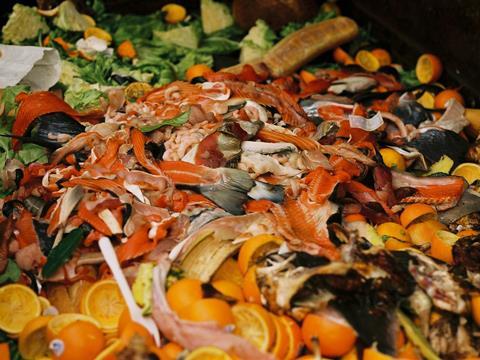
Toine Timmermans is one of Europe’s leading authorities on food waste. He leads the Sustainable Food Chains program at Wageningen University & Research, in addition to multiple roles in international projects, including coordinator of the EU projects FUSIONS and REFRESH. Ahead of his appearance at NVC’s Forum Resource Efficiency at Anuga Foodtec, Toine shared his insights on the barriers, opportunities and role of packaging with Tim Sykes.
I came to the Sustainable Food Chains program some fifteen years ago. Coming from a background was in engineering, I’d found that while designing things is great, innovations need to be put in a broader supply chain context if they are going to succeed. That’s why I started to work on the wider sustainability focus.
In the early 2000s we at Wageningen were among the first to look at the topic of food waste. What we immediately found, from studying lots of projects and possible interventions, was that there were huge potential gains but hardly anyone was implementing the solutions. After a couple of years we concluded that we also needed to explore the barriers that were preventing companies from adopting interventions that could save them millions. That was when we began to look at the broader food waste issues in the context of the enabling environment, collaboration across the supply chain, the roles of stakeholders and policy, etc.
These efforts later expanded to the FUSIONS program – moving from the national to the EU level – and the ongoing REFRESH project, which focusses on innovation, behaviour and the role of packaging in the effort to drive transformational change in our food systems.
Opportunities
In the present day I’d describe our work as mainly following an ecosystem approach: an emphasis on how the systems is governed, whether we’re looking at the private or public sector. For example, we’re looking at how legislation could be improved to enable a more sustainable food system. How can companies make better decisions if they are encouraged to look not just at short-term economic gains, but also at medium- to long-term societal and ecological gains? In fact, more and more companies and financial institutions are studying their wider impacts in addition to their financial performance. This is an exciting shift: these criteria are being taken seriously now and driving decision making in a way they were not in the past fifteen years. It generates new opportunities to make things happen, including in packaging innovation.
If we look at technology, one area of innovation that has potential for a big impact is the technology around big data, blockchain and transparent transaction models. There are intelligent packaging solutions that have been developed and not yet reached the marketplace, but which may emerge thanks to the growing interest in these types of technology. Part of the food waste problem comes from problems of over-supply. With better forecasting we can match supply to demand more accurately. Suppliers don’t always want to share all of their data with buyers and that lack of transparency can lead to waste. New supply chains with more readily available data leads to better forecasting.
Redefining norms
If we consider the potential impact, one of the best examples is online retail. The norm for a large retailer in Europe is a level of between 1.3 and 1.6 per cent of food waste. However, with these new business models, which have a more personalised understanding of demand, a new standard is set. These online retailers have more accurate forecasting and can sometimes even produce after the goods have been ordered. They have waste levels of up to one per cent lower.
That’s always important in food waste: once you have a new benchmark, the rest of the market has to follow. A retailer has a problem if it is losing one per cent of its profit compared to a competitor. The same holds true at the consumer level. It’s here in the home that by far the most food waste occurs – but nobody knows what the social norm is. When people are conscious of a norm, they are more open to adjusting their own behaviour. Right across the supply chain from an organisational level to consumers this is one key element of importance. It turns out that perceived norms have far more influence than factors such as money savings – which is why so many campaigns in the past had the wrong tone of voice and weren’t as effective they could have been.

Global lessons
This arena of digital, mobile-based transactions is likely to be driven by Asia – and probably in the future Africa. They are much more open to new technologies because they don’t have the lock-ins that we have. For instance, in China they don’t have the large-scale retail models we have in Europe. We’ll have a lot to learn from China.
On the other hand, we can apply the knowledge we have acquired through years of struggling with the same problems in Europe to identify solutions in places like Africa. For instance, we recently did a study looking at changing the supply chain for tomatoes in Nigeria, and the impact of replacing buckets with returnable crates. This simple step caused a dramatic reduction in food waste. Of course, changing a whole supply chain isn’t such a simple thing. Meanwhile, in Kenya we’re working with a company eProd, giving 300,000 smallholder farmers access to simple, scalable mobile solutions to communicate with their supply chain about demand, quality, etc.
The commitment problem
Despite the growing attention paid to sustainability impacts, lack of awareness and lack of commitment remain the biggest barriers to solving the problems. In 2017 the World Resources Institute, on behalf of the Champions 12.3 coalition, released a study whose results reinforced our own experience. Having studied interventions to reduce food waste across 1200 business sites around the world, it found a typical cost:benefit ratio of 1:14. Yet despite this fourteenfold return on investment (in addition to the positive ecological, societal, branding impacts) there are companies that still aren’t doing it.
There’s a proven model – set your target, measure your waste, take actions and measure again – which some of the leading companies are following. The crucial thing is to incentivise those companies that haven’t engaged yet because they haven’t thought about it or think it’s too complex.
This is perhaps part of our role at Wageningen, as we are independent of industry and can offer objective advice on strategies for cutting waste. There are lots of competing suppliers out there claiming to have the best packaging innovations but often companies don’t have the toolkits to assess their objectives in a broader structure and choose the right solutions.
The packaging problem
Now more than ever packaging is popularly seen as a negative thing due to the environmental impact of waste. As we know, it is also a positive thing which can bring food waste solutions at the systems level.
At Wageningen we work on both the food waste and packaging waste problems, so we view the situation holistically. If you look at it rationally, the environmental footprint of the packaging is on average somewhere between one and ten per cent of the product. In the public’s mind it is the other way around. However, it’s no good simply walking around repeating these facts. We need to respond to the concerns of consumers and follow a multi-stakeholder approach that responds to all the challenges. It’s clear we need to make packaging more circular, with design for recycling, focus on recycling rates, and working out how you can make new products out of packaging waste.
Again, we need to step back to assess the barriers and benefits – and bear in mind that no one will do anything if you offer businesses a proposition that if they invest one Euro, they’ll earn two. They will only listen if there is a return of ten Euros. They need to expect a big return to outweigh the risks and process changes that also come with investments in new packaging.
Overall of course investing a bit in more effective packaging has a positive effect on food waste. Our current work looking at certain types of value-added meat suggests it’s a no brainer to use vacuum or skin pack. The recommendation should be to implement it immediately on a wide scale and you’ll have nearly zero waste and better quality for the consumer. Nevertheless, there is a reluctance on the part of the industry to do it.
Here we should look at the role of marketing departments in specifying categories. Product designers are better placed to make judgements on environmental footprint but all too often it is the marketeer who has the final say. So in my opinion the task isn’t just to give the designer better tools to calculate impacts: the marketeer needs to change as well.
Recycling will be crucial to resolving the packaging waste problem. I don’t believe renewable materials alone can do the job. It’s great if we can develop more renewables, but if they can’t be recycled it won’t be viable and the ecological gains won’t be sufficient. We need to act quickly on recycling in Europe – particularly with China ceasing imports of our plastic waste.
All in all, we need to effect broader change across the sector. It won’t be easy but if we exert the right kind of pressure, set new norms, and follow the lead of pioneers in embracing technology, I think we can be hopeful of winning the food waste battle.

















